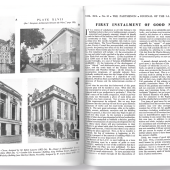Sudden collapse of 1850s stone balcony

Collaborative reporting for safer structures. Report 1279: Sudden collapse of 1850s stone balcony.
The property comprises a Grade II listed, four-storey mid-terrace house, built circa 1850 with solid external walls and a pitched roof.
The balcony was original and constructed of 60-millimetre-thick stone, possibly York stone, and projected 600 millimetres from the face of the building. The balcony had a cast iron balustrade around its perimeter connected to the main house. This fell with the stone balcony and fractured into multiple sections. Many properties in the area have similar balconies.
The stone balcony failed at the abutment with the main house. It was observed that the embedded section of the balcony was intact. By reassembling fragments from the collapsed balcony, the reporter was able to determine the construction.
It was observed that the balcony had a surface bitumen cement coating of varying thickness between 20-30 millimetres. This overlaid a cement/mortar bed of thickness around 10-15 millimetres. The cement and bitumen layers had mostly debonded from the original stone.
The reporter observed that while the upper surface of the stone was uneven with signs of delamination, the upper surface of the mortar bed was flat, suggesting that it had been laid to level the surface of the deteriorated stone.
Furthermore, the cement mortar bed was painted on its top surface, indicating that it had been applied many years before the bitumen layer, which the reporter understands was itself in position by 1966 when the current owner moved into the property. The current property owner is not aware of any previous balcony failures to adjacent properties.
Regarding the condition of the stone, it was noted to be quite soft and fragments were quite easily broken off with a hammer. The stone also appeared saturated, upper sections appeared delaminated and these could be easily removed in places. There was evidence to suggest that the bitumen layer had debonded from the cement mortar bed as there was localised dirt and debris on the lower surface of the bitumen and sections had warped. There were no signs of vegetation growth.
The reporter considered three potential failure mechanisms:
- bending failure of the cantilever stone section
- shear failure; and
- failure of the embedment into the building.
Calculations by the reporter, assuming York stone, suggest the balcony as originally constructed would not fail in either bending or shear. Inspection of the remaining stone embedded in the masonry confirmed that this had not been the cause of the failure. The main difference between the neighbouring intact balconies and the subject balcony is the later applied finishes. The neighbouring properties retain the original stone top surface. After further investigation by the reporter, it was observed that on the left-hand end the original stone was 40 millimetres thick and so too thin to function in bending.
The reporter concludes that the surface bitumen layer may have obscured cracks to the stone below or, alternatively, caused stress fractures over time as the thermal properties of the cement/bitumen and stone differed, leading to weakening of the projecting stone and its eventual collapse.
Key learning outcomes
For property owners:
- balconies can fail without warning and should be treated with caution; and
- inspect regularly for water accumulation and leakage at the critical juncture of the balcony with the building face.
For designers and inspectors:
the condition of the structure of cantilever balconies may not be obvious if the structure is covered. Such covering should be removed to enable an assessment to be produced with confidence.
Comments
Balconies (and their failure) have been a regular feature of CROSS Reports. A search of the website will show several relevant reports to this case, in particular Report 1001 Risks associated with historic stone balconies from December 2021 (b.link/CROSS_1001).
Stone balconies are a common detail on properties of this age and type in the UK. They are often painted, although they would have been originally unpainted. Painting stone can accelerate decay (preventing drying out and assisting possible frost damage). One might also expect paintwork to cover up any mortar repair to the stonework and resultant lack of structural performance from such repairs.
Ironwork railings were traditionally set in holes filled with molten lead within the stonework. This detail should allow differential thermal expansion between the metal and stone. If ironwork is bedded in holes filled with mortar (a common recent practice), then this could crack the stonework.
Cantilever balconies present a particular hazard as when they fail, they tend to do so both catastrophically and (to the untrained eye) without any obvious warning.
This report highlights the need to inspect and maintain balconies and that coatings can obscure faults. If the upper surface is covered (as in this case) removal of the covering is required to check the integrity of the structural material below. This is especially relevant with this type of construction, which is approximately 170 years old and likely not designed for such a lifespan – if indeed it was ever designed at all.
As no injury is reported, it seems the failure is not necessarily under added load from persons or planters on the balcony but rather due to deterioration of the balcony structure, which may not have been immediately obvious at the time. Regular inspections (and potentially maintenance) should be undertaken. Owners particularly should inspect regularly for water accumulation and leakage at the critical juncture of the balcony with the building face. If unsure, owners might consider the need for an inspection by a suitably qualified person.
It is fortunate that no one was injured either from being on the balcony at the time of collapse or being beneath it. Property owners need to be aware that balconies represent a potential risk not only to themselves but also their neighbours.
To subscribe to the CROSS UK newsletter (structural and fire safety concerns), visit cross-safety.org/uk/user/register







